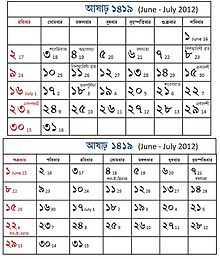Bengali calendar
The traditional Bengali solar calendar ( Bengali: বাংলা সন bāṃlā san, bangla shon ) was introduced under the Mughal emperor Akbar in 1584.
History
The oldest evidence of chronology in the Indian subcontinent, there are already in the Vedas, the oldest parts date back to about 1200 BC. From a later time, the Jyotisha Vedanga comes with treatises on astronomy and astrology. Greek and West Asian knowledge influenced in the first centuries AD, the Siddhantas ( astronomical textbooks). Above all, the Surya Siddhanta was the basis of all the calendar of the Indian subcontinent. The Arab conquerors brought with them the Islamic calendar. Under the Mughal emperor Akbar a Persian calendar was introduced in 1584 to unify the variety of different calendar systems for management. This calendar was used but only a few decades; In Bengal, then a modification of the traditional Hindu calendar was used. A reformed calendar - similar to the Indian National Calendar - was introduced in 1966 in East Pakistan, now Bangladesh. In the Indian states of West Bengal, Tripura and Assam on the Bengali calendar described here was used.
The year
The year is a sidereal year. In the Surya Siddhantas the length is given as 365.2587558 days ( 36.5 seconds 365 days 6 hours 12 minutes); other Siddhantas diverge from it by a few seconds. The actual value is 365.256360 days (365 days 6 hours 9 minutes 9.5 seconds ). The year consists of 365 or 366 days.
The annual count
In the calendar reform of Akbar in 1584 specified that the counting of the Bengali era (BS ) should match the count after the Hijrah. The year of his accession to the throne 963 AH Thus was the year 963 BS, at the same time the year 1555/56 AD As the Bengali calendar a sidereal year, the Islamic calendar but uses a lunar year, the Bengali count is now 14 years back: 1416 / 17 BS = 1431 AH = 2010/11 AD to determine for a year of Bengälischen era the year AD, must be added, depending on the season, 593 and 594 respectively.
The beginning of the year
The beginning of the year is determined by the entry of the Sun in the zodiac sign Aries. When embarking between sunrise ( start of day ) and midnight occurs, the year begins the next day, when the entry between midnight and sunrise occurs, the year begins on the next day, where there are special rules.
The accuracy
The Siddhanta - year is 365.2587558 days to 0.0023958 days (3 minutes and 26 seconds) longer than the sidereal year with 365.256360 days. Thus it moves in around 400 years by one day against the fixed stars. The Siddhanta - year is 365.2587558 days to 0.01656528 days (23 minutes and 51 seconds) longer than the tropical year with 365.24219052 days. Thus it moves in around 60 years, one day through the seasons. Currently, the year begins 23 days after the vernal equinox.
The month
The way the sun apparently travels in one sidereal year is divided into 12 zodiac signs of 30 °. Since the orbit of the Earth around the Sun is an ellipse, the sun is at its apparent path of different lengths in the different zodiac signs.
The beginning of the month
The beginning of the month is determined by the entry of the Sun into a new zodiac sign. When embarking between sunrise ( start of day ) and midnight occurs, the month begins the next day, when the entry between midnight and sunrise occurs, the month starts on the next day, and it still give special rules
The monthly length
The sun is at its apparent path of different lengths in the different zodiac signs. The time varies between 29.34806 days ( 29 days 8 hours 21 minutes 12 seconds ) and 31.61057 days ( 31 days 14 hours 39 minutes 13 seconds ). According takes one months 29-32 days and can be in different years have different lengths.
The names of the months, the months were originally after the lunar mansions ( Nakshatra ) named, in which there was the sun's entry into a new zodiac sign. The months of the year have the following names and corresponding data in the Gregorian calendar:
The days of a month are counted 1 to 29 and 32 respectively. The Bengali numerals can be found at Bengali digits.
The week
The week
The weekly schedule is Babylonian- Greek origin. The names are derived from the corresponding deities. The names are compiled in the following table:








